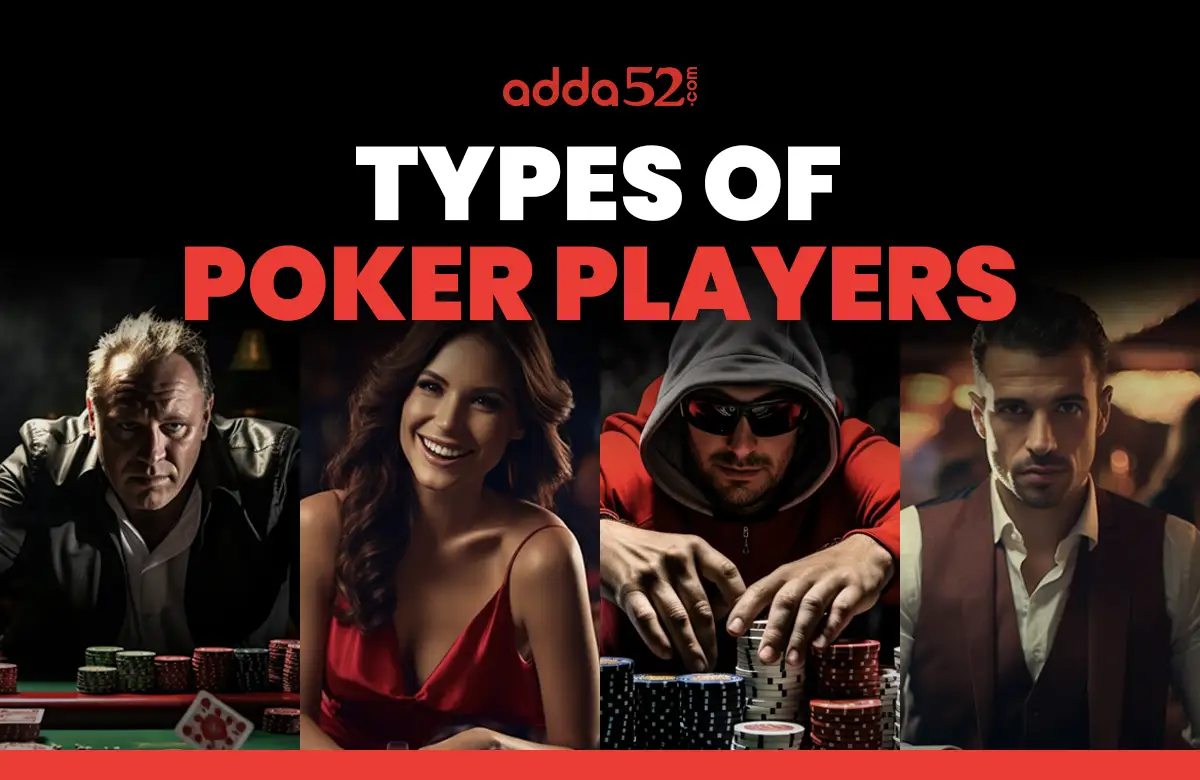
Introduction
We have read a lot about poker and its variants, but what about the players? You might have noticed that some players bet more aggressively, whereas others hardly bet. There are different terms for these player types, and you could be one of them.
In poker, understanding your opponents is as crucial as understanding the game. Every player has their style, and categorizing these styles can give you a competitive edge.
Types of Poker Players
Here are the main types of players you are likely to encounter on a Poker table.
- Tight-Passive: The Rock
- Tight-Aggressive: The TAG
- Loose-Passive: The Calling Station
- Loose-Aggressive: The LAG
- The Nit
- The Maniac
- The Shark
- The Whale
- The OMC
1. The Tight-Aggressive (TAG) Player
A TAG player selects hands carefully and plays them aggressively. They will fold most hands pre-flop, only entering the pot with strong holdings, like pocket pairs, high-suited connectors, or big face cards.
Example: You are in a game, and a player in an early position (EP) raises. If you know they are a TAG, you can assume they have a premium hand—like pocket Aces, Kings, Queens, or Ace-King. If you hold a hand like K-Q suited, it’s wise to fold here, as they likely have you beat.
How to Play Against a TAG: TAG players fold to aggression if they lack a strong hand. In a late position, you can steal their blinds frequently because they will fold weak hands. But avoid bluffing when raising or re-raising, as they probably hold a strong hand.
2. The Loose-Aggressive (LAG) Player
LAG players are unpredictable and play a wide variety of hands aggressively. They will raise with hands like 7♠5♠ or 10♥9♣, forcing others to make tough decisions.
Example: You are in a hand against a LAG who bets big on a flop of 6♠8♠J♣. They could have anything from a straight draw to a top pair. If you hold A♠J♥, you may still want to call down because they could be overvaluing a weaker hand or drawing.
How to Play Against a LAG: Stay patient and call down with solid hands. LAGs are often bluffing, so use their aggressiveness to your advantage. Trapping works well—if you have a strong hand, let them build the pot for you by calling their bets and raising on later streets.
3. The Tight-Passive (Rock) Player
Tight-passive players are highly selective and cautious. They rarely play unless they have a top-tier hand. They are more likely to check or call than to bet or raise.
Example: A Rock limps into a pot from the middle position (MP). This is rare because they usually fold preflop, so they probably have a marginal but playable hand, like pocket 8s or A-Q. You could raise here with a hand like K-J suited, as they’ll likely fold to pressure.
How to Play Against a Rock: Rocks are predictable, so you can exploit this by stealing blinds and betting into them. If they show aggression, however, it is usually a sign of strength, so proceed cautiously.
4. The Loose-Passive (Calling Station) Player
Calling Stations enter pots with a wide range but rarely raise. They love to call and see flops, hoping to hit a big hand, but often chase hands they should not.
Example: You are on the flop with K♠10♠, and the board is 10♦6♥4♣. A Calling Station calls your continuation bet. Even though they might be on a weak draw or holding a hand like 6♣7♣, they’re unlikely to fold to another bet on the turn or river.
How to Play Against a Calling Station: Don’t bluff Calling Stations — they will often call even with weak hands. Instead, focus on value betting when you have the top pair or better, as they will call you down with hands like the second or third pair.
5. The Maniac
Maniacs play wildly and aggressively, betting and raising with almost any hand. They enjoy creating chaos at the table and thrive on putting others on edge.
Example: A Maniac raises a big preflop from the button with a hand like 8♥4♠. You are holding A♣K♦ in the big blind (BB). You can confidently re-raise or even go all-in despite their aggression, as they likely hold a weak hand.
How to Play Against a Maniac: Let Maniacs build the pot for you. Don’t overplay marginal hands, but playback with confidence when you have a strong hand. Maniacs are often caught off guard by a big re-raise, as they are used to others folding.
6. The Nit
Nits are ultra-tight players who avoid risk and fold most hands unless holding something like Aces, Kings, or Queens. They play conservatively and rarely get involved unless they have the nuts.
Example: A Nit rises from an early position. This likely means they have a premium hand, so if you are holding J♠10♠, it is better to fold, as they probably have a dominating hand.
How to Play Against a Nit: Nits can be exploited by raising and stealing their blinds—they will fold most of the time. When they finally playback, you know they are strong, so only continue if you have a good hand.
7. The Solid Player
Solid players are adaptable and skilful, capable of switching between styles based on what is happening on the table. They make calculated plays difficult to read and can be tight or loose, depending on the situation.
Example: A Solid player raises in late position after a few players fold. This could indicate they are capitalizing on the folded hands and applying pressure with ranges like A-10, K-J, or suited connectors. You hold A-J in the big blind, and since you know they are likely pushing a wider range, a re-raise might be appropriate.
How to Play Against a Solid Player: Keep them guessing by mixing up your strategy. Solid players are skilled at reading opponents, so vary your betting patterns and avoid being too predictable.
8. The Fish
Fish are inexperienced or less skilled players who make frequent mistakes. They play hands they should not and call with weak draws, often failing to read the board correctly.
Example: You are on a flop of Q♠9♠3♣ holding K♠Q♣, and a Fish calls your bet with something like 4♠7♠. Even though they have a flush draw, they might not fold to a bigger bet on the turn, even if they’re behind.
How to Play Against a Fish: Play straightforwardly against Fish. Bet your strong hands and avoid complex bluffs, as they will likely call you with weak holdings. Keep the game simple, and capitalize on their frequent mistakes.
9. The OMC
OMC, or Old Man Coffee, is a slang nickname for a specific player. The general characteristics of an Old Man Coffee are:
- An older gentleman (Probably 60+ years old).
- Tight Passive Player.
- Usually retired and attend tournaments to pass the time and socialise.
Summary of Poker Personalities
Here’s the summary of poker player types:
| Personality | Tendencies | Our Strategy |
|---|---|---|
|
TAG Player |
Selective with strong hands and aggressive post-flop play. |
Exploit their caution by stealing blinds. Avoid bluffing their raises or re-raises—they likely have a strong hand. |
|
LAG Player |
Plays a wide variety of hands aggressively, making them unpredictable. |
Stay patient, call down with solid hands, and trap them when you hold a strong hand. |
|
The Tight-Passive (Rock) Player |
Very cautious, avoid betting or raising unless very strong. |
Exploit their predictability by stealing blinds and betting aggressively. |
|
The Loose-Passive (Calling Station) Player |
Calls frequently but rarely raises. |
Avoid bluffing, as they rarely fold. |
|
The Maniac |
Wild and aggressive, constantly raising and betting. |
Use big re-raises to catch them off guard. |
|
The Nit |
Ultra-tight and avoid risk. |
Exploit by stealing blinds—they will fold most of the time. |
|
The Solid Player |
They shift styles to fit the game. |
Mix up your strategy to keep them guessing. |
|
The Fish |
Makes frequent mistakes and plays weak hands. |
Avoid bluffs and capitalise on their mistakes by betting strong hands. |
|
The OMC (Old Man Coffee) |
Tight-passive often retire and play to pass the time |
Steal blinds often. |
Frequently Asked Questions
How to identify a Tight-Aggressive (TAG) player?
Look for players who fold often but raise with strong hands. Tags generally play only premium hands, so they are selective preflop and aggressive post-flop. If a player frequently raises from early positions and avoids marginal hands, they are likely a TAG.
How can a Loose-Aggressive (LAG) player be exploited?
Patience and hand strength are key. LAGs bluff frequently, so calling them down with strong hands often works. Avoid marginal hands, as they will test you with aggressive bets. Trap them by slow-playing your premium hands, as they will likely build the pot for you.
Which type of Poker players are the best?
People with analytical, patient, and adaptable personalities tend to excel at poker. Successful players can manage emotions, think strategically, and make calculated decisions under pressure. They are also skilled at reading others, quickly assessing risks, and adjusting tactics based on their opponents’ behaviour.
Are there different types of Poker?
Many poker variations exist, including Texas Hold’em, Omaha, Seven Card Stud, and Razz. Each game has unique rules and strategies, so players may prefer one type. Texas Hold’em is the most popular, but learning multiple variations can enhance overall Poker skills.
What is a donkey player in poker?
A player who plays badly and makes terrible decisions while playing. They often lose money.
Conclusion
The best Poker players can adapt their style based on their opponents. If you notice that the table is full of Nits and TAGs, you may adopt a more aggressive approach to exploit their tightness. Conversely, if LAGs and Maniacs surround you, you should play more conservatively and wait for strong hands to achieve better results.
